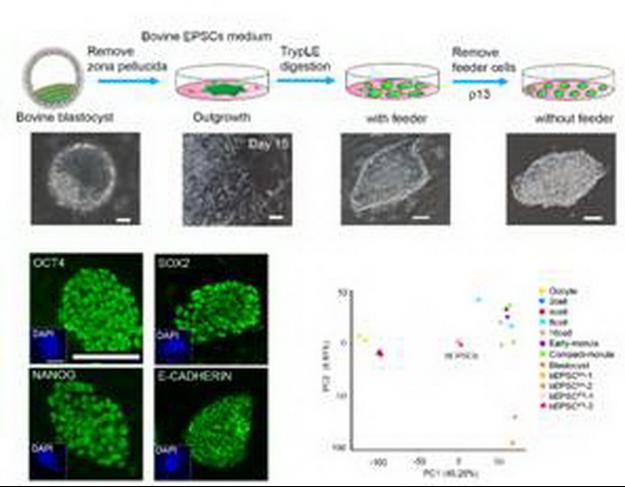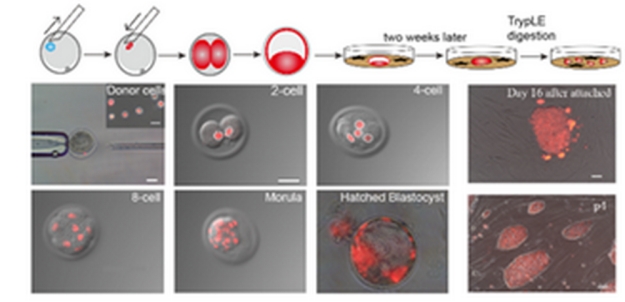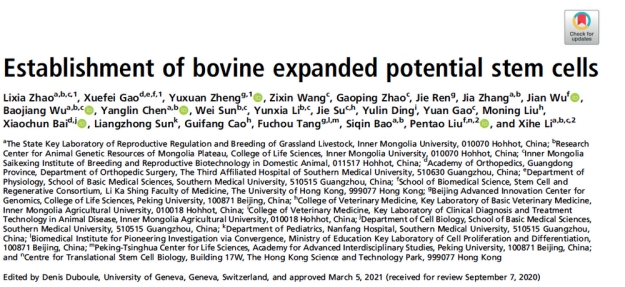Livestock stem cells not only are of great scientific significance in the realm of fundamental researches in life sciences, but also have broad prospects of application in animal breeding and human disease models. However, compared with achievements of researches in stem cells of laboratory animals and humans, no breakthrough has been made yet in key induction technologies for livestock stem cells--a key problem in the field worldwide--thus restraining the breeding and clinical application of livestock stem cells.
By applying TET-ON piggyBac system reprogramming technology and adopting the 8-factor Induction Group designed in collaboration with project partners and the stem cell special culture system developed by themselves, Prof. Li Xihe and his team conducted hundreds of experiments in five years on key technologies in stem cell induction and testing of key factors in stem cell culture, and eventually succeeded in obtaining two sets of bovine expanded potential stem cells--bEPSCips and bEPSCES constructed from somatic cells--bovine MEF and early embryonic cells--bovine Blastocyst. Stem cells differentiation and chimeric experiments in vivo and in vitro demonstrate that the two bEPSCs are of potentials of triple embryonic differentiation, with their stem cell biological positioning in the early embryonic 8-Cell-Morula phase, fully displaying new stem cell expanded potentials obtained in the present research compared against previous researches of the same category both at home and a broad.


Further studies show that the 2 groups of bEPSCs are capable of reconstructing cloned embryos through SCNT, and subsequently generating next-generation bovine new stem cells by induction with gene editing efficiency of 22.9%, indicating that the bovine expanded potential stem cells constructed by the research are of stable genetic properties, which is of great importance to livestock biological breeding and clinic application of stem cells. At present Prof. Li Xihe and his team have established germplasm dairy cow stem cell system of TOP genetic quality and have launched development and application of dairy cow biological breeding with this new technology.


The latest achievements of Prof. Li Xihe and his team of IMU in the research of new bovine stem cell was published in Proceedings of the National Academy of Sciences of the United States of America (PNAS) on April 9, 2021. The research took the lead in reporting the key induction technology and the biological features of bovine expanded potential stem cells (bEPSCs) without reliance on foreign genes and stands as a milestone achievement of scientific research in the field of grassland livestock stem cell research (See following chart for information of the thesis).

The research has Prof. Li Xihe from the State Key Laboratory of Reproductive Regulation & Breeding of Grassland Livestock and the Research Center for Animal Genetic Resources of the Mongolian Plateau of the School of Life Sciences of IMU and Prof. Liu Pengtao from Li Ka Shing Faculty of Medicine of the University of Hong Kong as the corresponding authors, and Dr. Zhao Lixia from IMU/Inner Mongolia Saikkexing Institute, Dr. Gao Xuefei from Southern Medical University and Dr. Zheng Yuxuan as the first authors, and was jointly conducted by Prof. Bao Siqin from the State Key Laboratory/the School of Life Sciences of IMU, Prof. Tang Fuchou from the BIOPIC Center of the School of Life Sciences of Peking University, Prof. Cao Guifang from the College of Animal Science of Inner Mongolia Agricultural University and Inner Mongolia Saikexing Institute. The project was sponsored by the National Natural Science Foundation of China, the Special Funds for Major Scientific and Technological Projects of Inner Mongolia Autonomous Region and the Funds for First-Class Discipline Construction of IMU.
Url for the thesis: https://doi.org/10.1073/pnas.2018505118

